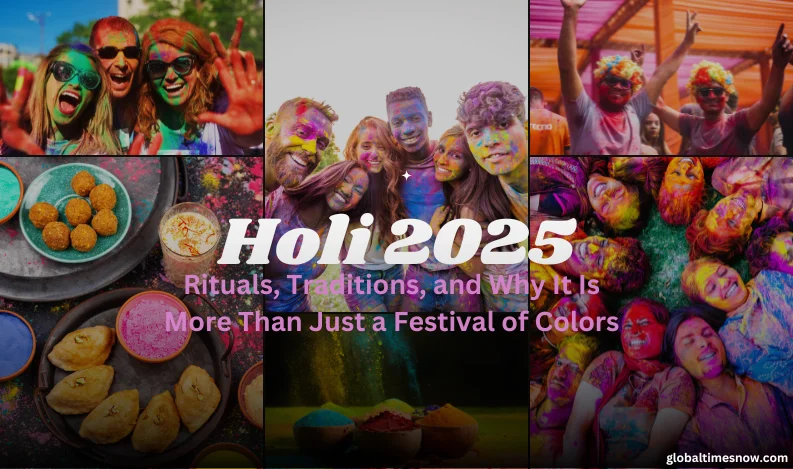Holi, the festival of colors, is one of the most vibrant and joyous festivals celebrated in India. It marks the arrival of spring and is deeply rooted in Indian culture and mythology. The festival is observed with enthusiasm across the country, bringing people together irrespective of their backgrounds. Holi is a time for unity, love, and forgiveness, celebrated with colors, music, and festive delicacies. In 2025, Holi will be celebrated on March 14, with Holika Dahan observed a day earlier on March 13. This article explores the rituals, traditions, and deeper significance of Holi, showing why it is more than just a festival of colors.
Holi 2025 Date and Muhurat
Holi is celebrated on Purnima (full moon day) in the Hindu month of Phalguna, which typically falls in March. In 2025, the festival will be observed as follows:
-
Holika Dahan (Chhoti Holi): March 13, 2025
-
Rangwali Holi (Color Celebration): March 14, 2025
Holika Dahan Muhurat
Holika Dahan, the ritual of lighting a bonfire, is performed in the evening before Holi. The auspicious time (muhurat) for Holika Dahan in 2025 is expected to be between 6:15 PM and 8:45 PM (timing may vary based on location).
Rituals and Traditions of Holi
Holi is celebrated with a combination of religious rituals, cultural practices, and social festivities. The festival consists of two main parts:
1. Holika Dahan (Chhoti Holi)
The night before Holi, people gather to perform Holika Dahan, symbolizing the victory of good over evil. The ritual involves lighting a bonfire to commemorate the story of Prahlad and Holika. Families offer grains, coconut, and sweets to the fire, seeking blessings for prosperity and protection from evil forces.
2. Playing with Colors (Rangwali Holi)
On the day of Holi, people celebrate by applying gulal (colored powders) on each other and splashing water. The streets come alive with music, dance, and laughter as communities unite to enjoy the festivities. The use of colors represents the essence of Holi—spreading joy and breaking social barriers.
3. Cultural Songs and Dances
Holi celebrations are incomplete without traditional folk songs and dances. In regions like Uttar Pradesh, Rajasthan, and Bengal, people sing Holi folk songs and perform dances like Rasiya, Gair, and Dhamaal.
4. Special Festive Foods
Holi is also known for its delicious treats. Some of the most popular Holi delicacies include:
-
Gujiya: A sweet dumpling filled with khoya and dry fruits.
-
Thandai: A spiced milk-based drink, often mixed with bhang.
-
Dahi Bhalla: A savory dish made of lentil dumplings in yogurt.
-
Puran Poli, Malpua, and Shakarpara are other regional Holi favorites.
5. The Role of Bhang
In many parts of India, bhang (an edible preparation of cannabis) is consumed during Holi. It is considered an ancient tradition that dates back to Lord Shiva. However, it is important to consume it responsibly.
The Deeper Meaning of Holi
Holi is not just about colors and celebrations; it carries deep cultural, social, and spiritual significance.
1. Victory of Good Over Evil
The burning of Holika represents the triumph of righteousness over wickedness, reinforcing the importance of faith and devotion.
2. Celebration of Love and Unity
Holi dissolves social and economic differences, bringing people together. It is a festival where forgiveness, reconciliation, and new beginnings are encouraged.
3. Change of Seasons and Agricultural Significance
Holi marks the transition from winter to spring, celebrating the blossoming of crops. It is a time of joy for farmers as they prepare for a prosperous harvest season.
4. Spiritual Renewal
Playing with colors represents letting go of negativity and embracing happiness and positivity. The festival signifies a renewal of the soul and a chance to start afresh.
Regional Variations of Holi Celebrations
Holi is celebrated uniquely across different regions of India. Some notable variations include:
-
Lathmar Holi (Barsana & Nandgaon, Uttar Pradesh): Women playfully beat men with sticks in a traditional re-enactment of Krishna’s teasing of Radha.
-
Phoolon Ki Holi (Vrindavan): Instead of colors, flowers are used to celebrate the festival.
-
Royal Holi (Rajasthan): Celebrated with grandeur, especially in Jaipur and Udaipur, where royal families partake in the festivities.
-
Basant Utsav (West Bengal): Known as Dol Jatra, Holi is celebrated with cultural performances and processions.
-
Manjal Kuli (Kerala): The festival is observed with turmeric water instead of colored powders.
Modern Adaptations of Holi
With modernization, Holi celebrations have evolved to include:
-
Eco-Friendly Holi: People are shifting to organic, chemical-free colors and minimizing water wastage.
-
Music Festivals & Parties: Holi music festivals featuring DJs and live performances are gaining popularity.
-
Corporate Holi Events: Many companies organize Holi parties to foster team bonding.
Holi Safety Tips
While Holi is fun, it’s essential to celebrate safely:
-
Use organic, skin-friendly colors to avoid allergies.
-
Protect your skin and hair with oil before playing.
-
Wear sunglasses to shield your eyes from colors.
-
Drink responsibly and avoid excessive consumption of bhang.
-
Stay hydrated and use sunscreen to prevent sunburn.
Conclusion
Holi 2025 is not just about colors; it is a festival of unity, tradition, and deeper cultural significance. Whether it is the spiritual meaning, historical legends, or festive celebrations, Holi continues to spread joy and harmony across the world. As we celebrate this ancient tradition, let’s embrace its true spirit—spreading love, positivity, and togetherness.
Wishing everyone a Happy and Colorful Holi 2025! Holi Hai!
You may also like:-
- From Past to Present: Celebrating the Evolution of Women's Leadership on International Women’s Day 2025
- Seasonal Sensations: Celebrating the Best of Every Harvest in Your Kitchen
- Advancements in Gene Therapy: Paving the Way for Treating Genetic Disorders














